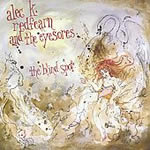|
|
 |
Dusted Reviews
Artist: Alec K. Redfearn & the Eyesores Album: The Blind Spot Label: Cuneiform Review date: Jul. 27, 2007 |

|
|
|
 |
If you’re not familiar with Alec K. Redfearn and his Eyesores ensemble by now, you should be. Since 2004, the Providence accordionist has treated audiences to a new full-length each year, ever-expanding his band, their sound, and the brooding arrangements that they create. Fresh for 2007 is The Blind Spot, a record more intimate, demented and heart-breaking than any of their past releases, mainly due to a greater emphasis on songwriting and harmonic tug-of-war, rather than the punk-infused technical romps exhibited on their past five full-lengths. Taking center-stage is Redfearn’s eight-part song-cycle, “I Am the Resurrection and the Light” – a work dedicated to loved ones lost to drug overdose, written with a close-to-home account of personal addiction and bewildered imagery. Not the most uplifting of topics, sure, but the group’s work here is gorgeous, weaving a host of horns, strings, percussion, voices and electronics into rich compositions that possess an eerie innocence in the face of impending doom.
It’s interesting to see the ensemble gravitate further toward an altogether gentler sound, veering away from the frantic instrumentals practiced since the group’s inception and focusing on a more contemplative and concentrated brand of Balkan-rooted opera. Redfearn’s involvement with Providence theater glows in the progression of the album, taking the listener through a snaking play of tormented characters, constantly searching for a glimpse of mercy through the dissonant opposition. Disoriented by the multi-tracked mouth harp and mounting buzz from distorted keys, it’s hard not to get lost in the group’s bizarre little stage play that constantly takes turns toward heroin-laced soundscapes, emanating unsettling groans of bad choices and a sack of regrets.
Though the first three tracks stand somewhat separately from the song-cycle, they still fit the mood. “Queen of the Wires” introduces the album with a tale of Bettina, an ill-fated mistress who meets an untimely demise after long teetering on a proverbial tight-rope. She could be the disheveled-looking girl on the album’s cover, with her ”cold vacant stare” violently giving way to a ghostly swan – a representation of the beauty that the album strives toward in the face of hopeless reality. The emphasis on songwriting is probably the most impressive improvement here, evolving from the snarky, religious-oriented lyrics of old and delving into developed abstractions that place the vocals at the forefront. The rising voices sing through the violin’s whines, breathing in the accordion’s keys and melting all the elements together in a mind-numbing hum of churning electronics. Both Redfearn and longtime collaborator Frank Difficult are credited with the loops and incorporated noises within, adding an ominous depth to the chorus of acoustic instruments and overtaking the sound much more than previously allowed – an evolution that complements the album well.
“I Am the Resurrection and the Light” begins with “Blue and White,” carrying a melody that glimmers with the possibility of hope, but dangles nervously on Bettina’s high-wire with an underlying uneasiness. Things get a bit more intense from there, diving into gypsy rhythms and working through downtempo dirges of interwoven musical influences. The melodies resonate beautifully, but more often than not they soon grow into a pulsing drone of voices lost in a whirlwind of sound, brought on by wayward electronics that sear the pieces together at the ends. A much stronger female presence often takes hold of the songs, with the layered vocals of Laura Gulley, Ellen Santaniello, and Fern Knight’s Margie Wienk harping beautifully in contrast to the dark instrumentation. Though a bit cheesy on the surface, the vocals soon give way to an involving pool of multi-tracked mayhem that comes on slow but dances as frenetically as the distorted accordion instrumentals did on Eyesores’ albums past.
Tarnished by wayward souls and an inevitable fall from grace, The Blind Spot creates a world filled with flesh-eating monsters that lurk at the edges. But the angels are there, too, floating in every now and then, just to show that they do exist. It seems that the demons win out though, overtaking the album’s closer, “Blue and White (reprise),” with a cascade of radiator hums and nightmare furnace growls. But just before the album ends, the morbid drone of Steve Jobe’s self-built hurdy-gurdy is cut short by a flicker of rising strings – a brief glimmer of merciful possibility just out the eye’s reach.
By Cole Goins
|







